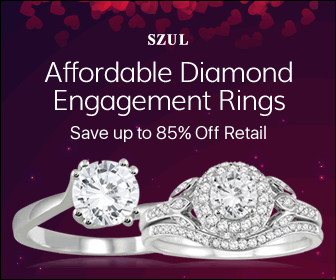| The Four C's - Color
The color of a diamond is the second major characteristic used in determining its value. The "ideal" diamond is considered "colorless." The Gemological Institute of America (GIA) is well-respected for its consistent and conservative
grading standards. Its Color Grading Scale
is used widely in the industry:

An "ideal" diamond, if it existed, would be chemically pure and structurally perfect with no tint, hue or color, and would fall into the A - B grade range. In reality, however, white diamonds are classed no higher that "D" in color. Why? Because most diamonds are slightly colored due to the presence of elements, such as nitrogen that gives a diamond a yellow to brown cast or boron that gives a stone a blue cast.
Most white diamonds are discounted in price as more yellow hue is detectable, while intense pink or blue diamonds, such as the famous Hope Diamond can be of very high value and are called "Fancy Diamonds.

The Hope Diamond
The GIA Color Grading Scale uses a "benchmark" set of natural diamonds of known color grade, along with
standardized and carefully controlled lighting conditions to categorize any one diamond. The categories as set forth in the GIA Color Grading Scale and illustrated above are:
D-F: Colorless: The finest and brightest
diamonds with perfect or almost perfect color
G-J: Near Colorless: Good to very
good color to the point where when mounted, the diamond may look
colorless
K-L: Light but noticeable yellow or brown
tint: diamonds may "face up" colorless when mounted in yellow
gold
M-Z: The color is noticeable
C+ : Light Fancy: Diamonds have a champagne, cognac. greenish, brownish or yellow color
Fancy - Fancy Intense - Vivid: Diamonds have a canary yellow, green, blue, purple, pink or red color
The color of a diamond is also influenced by a condition called "Fluorescence" or photo-luminescence. It is activated by UV light. Grading Certificates usually describe fluorescence as being "None," Faint," "Medium," "Medium Blue," "Strong," Strong Blue," and "Intense Blue." Fluorescence has traditionally been considered a positive condition. Today,the GIA still considers it so, however, if you are searching for a D,E, or F color diamond, fluorescence should be avoided since it may detract from the diamond's color making it look a bit hazy. If you are considering a G, H, I, J, or K color diamond, fluorescence is a plus helping whiten the diamond one or more grades.
The Four
C's:
| Carat (weight) | Color | Clarity | Cut | |







